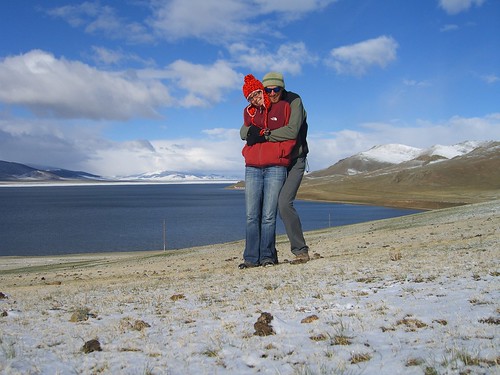
Day 11 – At White Lake
The night was a cold one,
and we huddled deep into our sleeping bags.
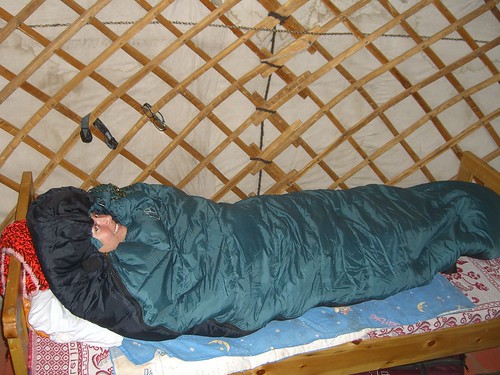
The wood-fired stove had
gone out relatively early. It was raining when we went to bed, and
turned from a steady pour to a full-on gale during the night. I
awoke several times during the night when the whole ger would shake
under the gusts. I doubted the stability of a structure which is
basically shaped like a wing, but I needn't have. Eventually the
storm blew through without tearing our room from over our heads.
We never once had a stove
with a flue or any other means to control the speed of wood
consumption in the stove. Add more wood, and it would burn hotter,
but never very long. This was less of an issue on the previous
nights, when the desert would turn cold, but not bitter. Here the
air was thin and damp, and the night very, very cold – spilling
into your sleeping bag through any uninsulated parts.
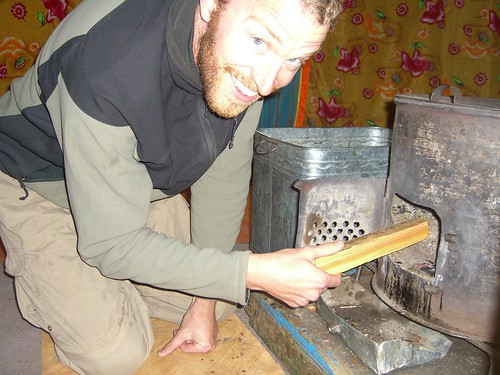
The stove is
made of thin metal, and so holds no heat of its own. I was tempted
several times to add some stones to the stove so that at least
something would contain heat during the night, but never did. I
doubt it would have really worked anyway.
The sun rises early, and I
could see the light out the little window of our ger. Lots and lots
of light. It was still very cold, but nature called. I did my best
to pull on my fleece and socks before getting out of my sleeping bag.
When I opened the ger door I was nearly blinded by the high mountain
light. It was then that I realized it had snowed during the night.
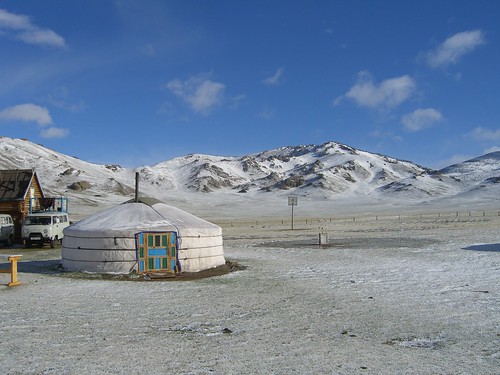
It was very beautiful, and
I grabbed my camera for a few photos before I crawled back into bed.
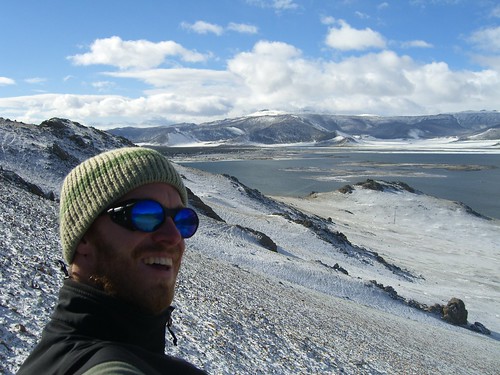
By the time I reawoke, the snow had already surrendered much of its
substance to the sun, now high over us.
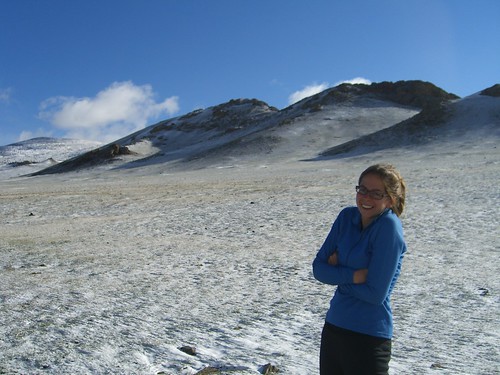
It was a lazy day, and we
used the cold and snow as an excuse to abbreviate our ventures
outdoors and to bury our noses in books and card games. That
afternoon we opted to go on a horse ride, in part because Andre and
Natalya had forged the path for us and been supplied traditional
Mongolian riding coats by our hosts. Thick and woolen, we wore these
over our winter digs with much success.
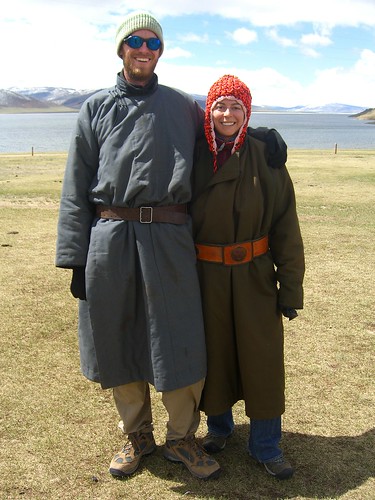
Note though, that the
sleeves on this thing are supposed to be so long as to cover your
hands (obviating the need for gloves). It was fun, but these horses
were super slow, I could have easily outpaced them in flip-flops,
much less in hiking boots and with a good walking stick.
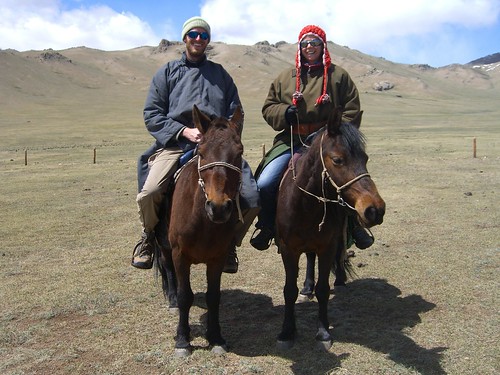
It snowed again that
night, and the next morning we were prepared, but no less enchanted
by the lighter dusting.
We packed the van and were
off the next morning. It would take us two days of long rides to get
back to UB, but we were now on our way home. The back of the van
seemed suddenly VERY full. I lifted the tarp to see what the extra
load was. Apparently coming up short of engines to work on, Bud,
Rink and Doc had helped the family cut and split firewood. In
return, Doc was taking home several unplit logs of firewood for his
family.
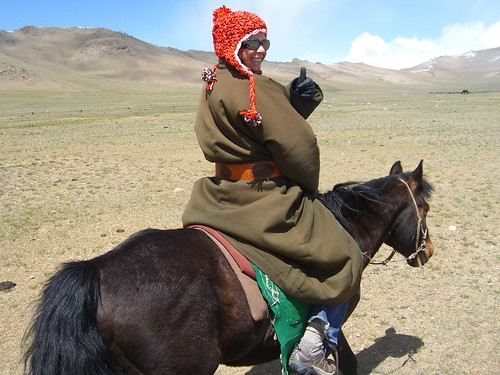
Day 12 – Drive to
Kharkorum
On the way to Kharkorum, we got another flat tire.
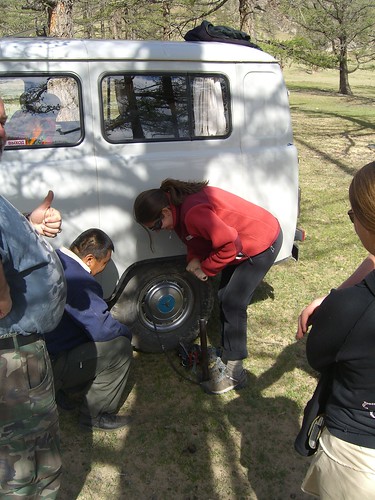
The route to Kharhorum
took us through Tsetserleg, and we again had lunch at the only real
restaurant in 300 miles. We actually got to meet one of the owners,
but forgot to ask what religion he was a missionary for, so this
remains a mystery. In any case, I am happy to report that he is a
very friendly emissary for whoever it is.
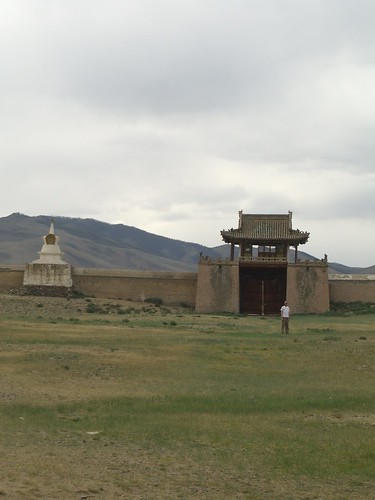
At Kharkorum we had time
to explore the old empirical palace. Ghengis Khan never established
a permanent capital, instead maintaining the mobility that gave the
Mongols their initial strength. But his grandson, who would briefly
rule the eastern half of the empire, built a capital to rival the
ages here. Tribute poured in from across the known world – the
Mongol empire stretched from the Pacific, past the Urals along the
shore of the black sea, and to the edge of Egypt. It was Kharkorum
that was visited by Marco Polo.
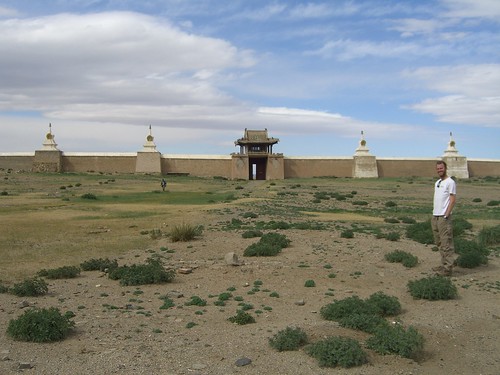
Little remains of the
original capital, in part because much of the greatest treasure went
with Kubla Khan when he moved his capital to what is now Beijing and
became the Chinese Emporer. But some buildings are being restored,
and the original palace walls are in place.
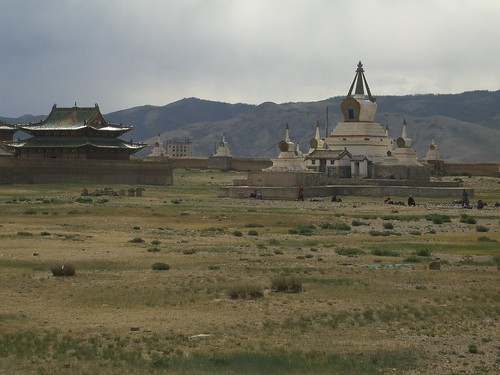
That night we commissioned
a performance of traditional Mongolian music in our ger. The two
musicians were throat singers and played several traditional
instruments. It was very cool.
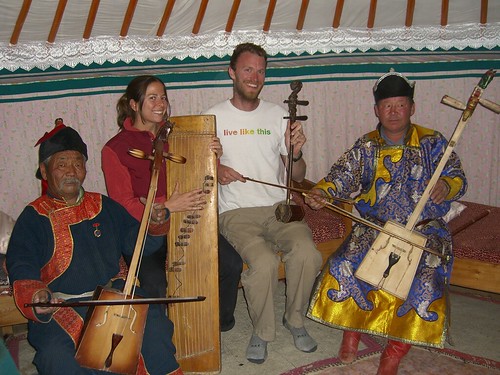
Though we had decended
quite a bit in altitude, the winter weather had followed us. That
night it snowed. The loo was only fifty feet or so away from the
ger, but the door wasn't on it's hinges, just sort of propped at an
angle that provided for some modesty unless you are standing right in
front. Not that it would have mattered much, the wood for the walls
was rough hewn, and the gaps between the boards was wide enough for
your pinky. The outhouse also backed against the fence, the other
side of which provided backboard for a basketball hoop.
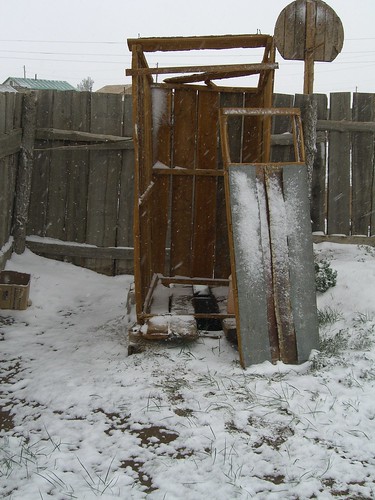
When we
first got here Susan aborted a trip to the loo when the transparency
of the fence and the proximity of kids playing basketball basically
meant that that you had anonymity but not privacy. It was all
academic at this point, you don't spend two weeks camping in the
desert without learning some skills to politely avert your attention,
except that the gaps admitted both sight and snow.
It snowed that night, and
the wind howled. I ventured forth from the ger late in the night,
and could see only a few feet with the light from my headlamp. The
lowing snow was so thick and fast I thought it was a sandstorm. But
the next morning the wind had calmed and in the light of day we could
clearly see the five-or-so inches of fresh snow on the ground. It
would make for an interesting drive to UB, as the wind had calmed,
but the snow was still falling fast.
Day 13 – Drive to UB
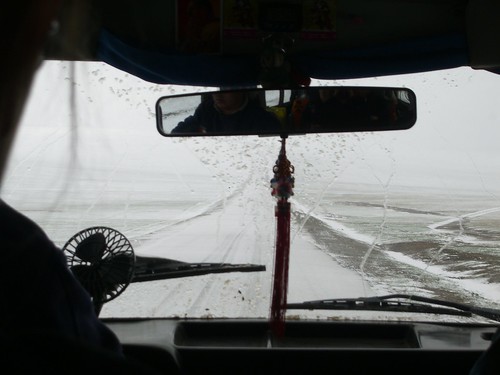
As much fun as we had had
camping, the prospect of a pivate room and a real bed with sheets was
very welcome. No amount of snow, slippery road, or near-collisions
with sliding trucks could dampen our enthusiasm.
It was a long drive, and
the morning was white-knuckle as we weaved around cars and trucks
mired in the deep snow. Four wheel drive is the norm here, but the
sheer depth of the snow made ground clearance an equally vital
factor. We passed many, many other vehicles that would have to wait
for the afternoon sun to melt the snow before they would be able to
proceed.
Eventually we did escape
from under the storm, and as we approached UB the route cleared. We
even started to recognise that we were driving on a real road. The
foreign aid dollars are being put to use on infrastructure, and a big
priority is the linking of population centers. This was the first
place we saw any pieces of real construction equipment. Haulers,
loaders, dozers, graders, and the like (I noted with a tinge of
nationalistic sadness that most were Bombardier, and none
Catapillar). And we saw them rather up-close.
The road is under
construction but it is still the road. There are no flagmen, detour
signs, or closed roads. Cars weave around moving construction
equipment, and occasionally we found ourselves on the wrong side of
berms of gravel or soil that were stretched for kilometers without a
break, awaiting the crews to lay the foundation for the road.
Several times we came to a point in the road where the entire tarmac
was blocked by a pile of rock. Sometimes there was a rather
redundant sign with an arrrow indicating that you can't go straight.
So it was that even where there was paving, we spent about half the
time paralleling the asphalt.
But we made it, in one
piece and with high spirits to the UB guesthouse, hot showers and
clean beds. the next morning Susan and I were to fly to Beijing,
connecting to Bangkok where we would spend a night before hopping a
puddle jumper to Luang Prabang Laos for some rest. This was all part
of “Plan B” which we formed when it became evident China was not
going to open Tibet as promised. Little did we suspect that Plan B
would also be altered by China...